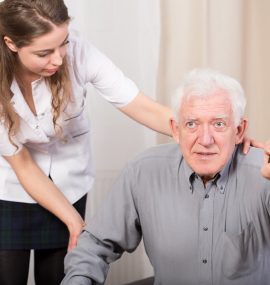Leg strength is best predictor of staying out of a nursing home
Older men and women can build leg strength
What would you guess is the most feared condition for older people? According to a 2007 study, Aging in Place in America, seniors fear losing their independence and being confined to a nursing home more than they fear dying. Hip fractures are a major cause of nursing home admission. An Australian study of 194 women age 75 and older revealed that most would rather die that sustain a hip fracture that would place them in a nursing home. A long-term study showed that physical exercise predicted reduced risk of hip fractures resulting from falls.
Researchers at Harvard studied the previously puzzling effects of various types, intensities, and duration of exercise on participants in the Nurses’ Health Study. Activity intensity was evaluated in terms of Metabolic Equivalent Task (MET) hours per week and grouped into five classes. For context, walking briskly for one hour requires 4 METs of energy. The median time of follow-up from the point of menopause was 11.6 years. Compared to post-menopausal women in the lowest category of activity (less than 3 MET-hours per week), those in the highest category of activity (more than 24 MET-hours per week) had 55 to 62 percent lower risk of hip fracture, depending on which statistical model was used. The risk of hip fracture declined by 6 percent for every additional hour of brisk walking per week. For post-menopausal women, brisk walking for 30 to 60 minutes per day can reduce the risk of hip fracture and diminish their likelihood of ending up in a nursing home.
Elderly persons typically lose muscle strength, which has been attributed to being older and reduced physical activity. Can sedentary elderly men regain sufficient strength to perform the activities of daily life? Researchers at Tufts University Center on Aging recruited 12 sedentary men aged 60 to 72 for supervised leg strength training. After 12 weeks of progressively demanding training, the men showed significant gains in leg strength. The cross-sectional area of thigh muscles increased by 11 percent. The size of muscle fibers also increased. Older men markedly increased leg strength with a vigorous exercise program.
Can very old women and men improve their leg strength? Researchers in Boston recruited 10 frail but ambulatory, institutionalized volunteers (four men, six women) ranging in age from 86 to 96 for a strength training study. The subjects participated in eight weeks of high-intensity weight training designed to improve leg strength. The training led to statistically significant and clinically meaningful increases in leg strength in all nine subjects who completed the training. The average subject increased leg strength by 174 percent. Total mid-thigh muscle area increased significantly by an average of 9 percent. The time required to tandem-walk (at each step, the toes of the back foot touching the heel of the front foot) six meters declined significantly from 43.4 to 29.6 seconds, indicating that balance improved. Frail nursing home residents ranging in age from 86 to 96 benefited from high-intensity strength training.
If you feel that your strength is declining, do something about it. If infirm, very old folks can improve their strength, you can, too. Or would you rather end up in a nursing home?








